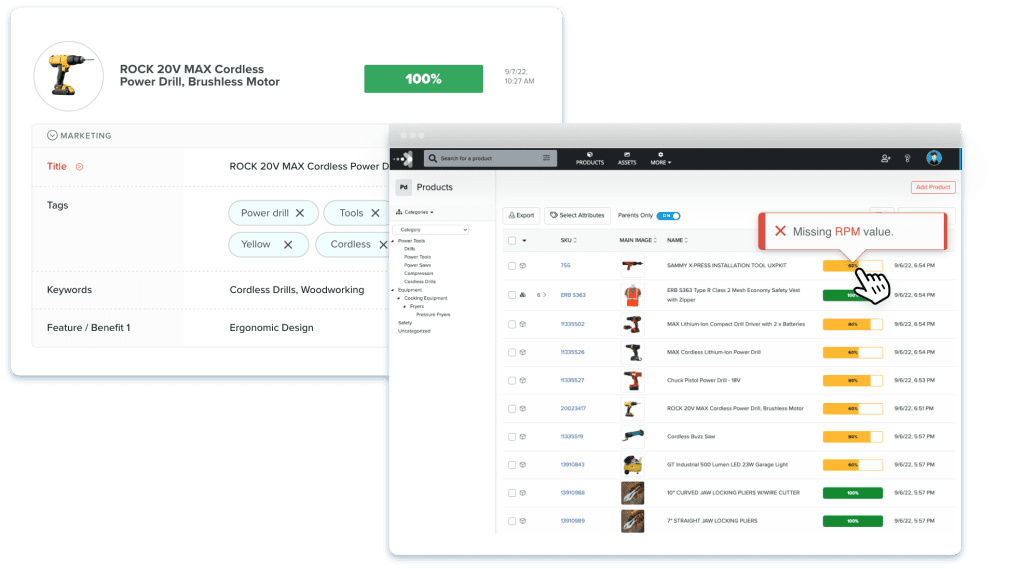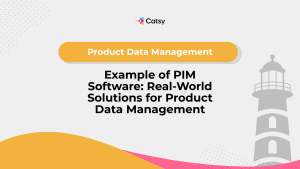The Evolution of Product Information Management: Transforming Product Management in the Digital Age

- PIM solutions evolved from basic catalogs to handle the digital age's vast, complex product data.
- PIM software centralizes product data, ensuring accuracy and consistency for a better customer experience.
- The future of PIM solutions lies in AI-powered automation, adaptability to changing market needs, and top-tier data security.
In this Article
Industrial brands know that organized and optimized product data is a powerful asset. The conviction comes from the knowledge that success hinges on launching new products, building seller relationships, and conquering new sales channels – all at an increasingly rapid pace. This means managing even more complex product data, all while striving for faster time to market.
Said in fewer words: The era of relying on error-prone spreadsheets is over. Product data is evolving faster than traditional systems can handle. Today, brands want the sharpest tool in the shed – product information management solution – to satisfy demands for complete, accurate, and customer-centric product data.
Data management places substantial weight on brands’ shoulders, and PIM tools are always on hand to save the day. However, do you know what life was before the solutions? Perhaps a glance at the past and what transformations PIM tools have engineered in product management is an excellent lesson for today’s users to appreciate them more. This post takes you through the evolution of PIM software solutions.

What is Product Information Management (PIM)?
Product information management is the process and tools used to manage and enrich product data. PIM software is the core of this system – the tool collects product information from several sources and organizes it in a centralized hub. This hub creates one source of truth from which high-quality and current product data can be syndicated to channels.
This capability – a single source of truth – enables brands to maintain consistency, accuracy, and completeness across multiple channels.
The benefits of the PIM Tool for industrial brands and entire teams to manage product data
- Improved product data quality: PIM tool allows organizations to maintain the most accurate and up-to-date product information. The syndication feature enables them to keep this data consistent across all channels, enhancing the overall customer experience and fostering trust in the brand.
- Increased efficiency: The tool automates various tasks, such as data validation and enrichment, reducing the time and resources required for product information management.
- Faster time-to-market: Many robust PIM solutions provide templates to expedite the product data management process. This way, brands can quickly and easily launch new products, enter new markets, and onboard new sellers.
- Enhanced collaboration: The centralized hub that PIM solution creates is accessible by authorized users. So, everyone across the organization and external partners works with the same accurate and up-to-date product information.
- Scalability: Brands that choose a cloud-based PIM solution, such as Catsy, can acquire more operating space as their product offerings expand. The best part is that they can also scale down usage. This flexibility and scalability certainly provide an edge for companies operating in competitive industries like manufacturing.

The Origins of PIM
Product information management has roots that predate the technologies we’ve grown to love today. We can divide the evolution of PIM into three distinct eras, each defined by a specific piece of technology.

The product catalogs era
A product catalog is a systematic compilation of product information and related materials designed to showcase goods or services to potential buyers. Traditionally, product catalogs were printed books or pamphlets, but modern versions often exist as digital publications and websites.
Typically, product catalogs showcase basic information like descriptions, features, dimensions, weight, price, color, availability, etc. The format can vary based on a company’s unique needs, from PDF files to printed magazines.
Product catalogs have a rich history in shaping how businesses sell. In 1498, Venetian publisher Aldus Pius Manutius revolutionized bookselling by creating a catalog showcasing his available titles. This enabled customers to browse his collection and make purchases from afar.
Benjamin Franklin propelled the industry by launching a mail-order book catalog in 1744. This innovation allowed people to conveniently order from his selection without visiting a physical store, laying the foundation for the mail-order business as we know it.
The late 19th century saw another landmark moment when Richard Sears and Alvah Roebuck’s “Book of Bargains” transformed the industry. This groundbreaking catalog offered farmers more comprehensive access to various goods at set prices.
Read Also: PIM Catalog Management
But while effective for their time, these catalogs had several limitations, including:
- Limited reach: Printed catalogs could only be distributed to a small audience, restricting the potential customer base.
- Time-consuming updates: Making changes to product information or introducing new products requires reprinting the entire catalog, which is costly and time-consuming.
- Inconsistency: Maintaining consistency across multiple catalogs, especially for businesses with diverse product offerings, was challenging.

Spreadsheets and databases era
The invention of the computer, while it didn’t immediately launch digital technologies into mass adoption, enabled spreadsheets to exist. These spreadsheets – computer programs that allow users to store data in tabular form – enabled businesses to manage larger volumes of product data more efficiently.
However, they, too, had their limitations, mainly when it came to managing large volumes of evolving product information:
- Data silos: Spreadsheets were often managed by individual departments, leading to segregated data and inconsistencies in product information.
- Manual processes: Updating product information, validating data, and ensuring consistency across multiple spreadsheets requires too much human effort.
- Limited collaboration: Spreadsheets were not designed for real-time collaboration. The support teams would have to share them for changes, which is time-consuming. This makes it difficult for teamwork in product information management.
Meanwhile, databases also matured as data storage and management solutions. These robust systems offered a significant leap forward for structured storage and product data retrieval.
Databases represented a significant shift in the way businesses approached product data. They offered several advantages over their spreadsheets, including:
- Centralization: Databases could act as a somewhat centralized store of data, reducing redundancy compared to scattered spreadsheets.
- Improved organization: Databases introduced a sense of order to the chaos of product data. This meant less time wasted searching for information and more time focusing on selling.
- Improved data quality: The structured nature of databases allowed for better data validation and consistency, ensuring the accuracy and reliability of product information.
- Scalability: Databases could handle larger volumes of data, making them more suitable for businesses with extensive product offerings.
Despite these advancements, databases still had shortcomings, mainly regarding user-friendliness and omnichannel needs. For example:
- Managing databases often requires specialized technical skills, making it difficult for non-technical users to access and update product information.
- Databases were not designed to accommodate the diverse and evolving product information requirements of various channels, such as e-commerce platforms, mobile apps, and print catalogs.
- Similar to spreadsheets, databases were not built for real-time collaboration. This means challenges for teams trying to work together on product information management.
These drawbacks highlighted the need for a more user-friendly, flexible, and collaborative solution for managing product information. This set the stage for the development of dedicated PIM tool.
The era of specialized PIM solutions
The PIM solutions we know and love today have existed since the 1990s. At this time, spreadsheets and raw databases were the prevalent platforms for storing and managing product information.
However, it is crucial to state that PIM solutions did not retire databases. Instead, they built on this technology to provide better capabilities and efficiencies. The core of PIM solution, which covers the storage engine and other fundamental processes, is an extension of database technology.
While PIM platforms do leverage the foundational structure of databases, they represent a significant step forward. They were designed from the ground up to tackle the complexities of modern product data management while addressing the inherent limitations of raw database technology.
PIM tool is different from raw database technology in several ways:
- User interface: PIM solutions offer a user-friendly interface, making it easy for non-technical users to access, manage, and update product information without requiring specialized technical skills.
- Data model flexibility: The software provides a flexible data model that can be customized to accommodate the unique and dynamic product information requirements of various channels, unlike traditional databases with rigid structures.
- Collaboration and workflow management: PIM solutions enable real-time collaboration and streamline the approval process for product information updates.
- Integration capabilities: Most robust PIM solutions have pre-built connectors and APIs for integrating with other business applications, such as ERP, CRM, and e-commerce platforms. This allows seamless data transfer across the platforms.
- Data enrichment tools: PIM tools go beyond storage, offering features like attribute editing, translation, and automated product categorization to optimize your data for maximum quality.

Digital Transformation and the Evolution of PIM
The e-commerce explosion
Online shopping (e-commerce) is the ultimate manifestation of the successes of digital transformation. Initially, the retail version of e-commerce was dominant, with consumers driving the demand for more online shops. However, Statista data indicates that the global B2B e-commerce market is now five times larger –valued at $20.4 trillion in 2022.
Regardless of which sector pulls more weight, the e-commerce explosion created an unprecedented need for businesses to reimagine their product information management strategies.
Firstly, the demand for rich, efficient, and persuasive product content skyrocketed. Since customers could not experience products physically, the quality and comprehensiveness of the information showcased at various touchpoints became crucial in influencing purchasing decisions. For instance, customers demanded detailed descriptions, high-quality images, videos, and other interactive content that could effectively convey product features, benefits, and value propositions. PIM tool evolved to meet this need. The solution provided brands with the tools to create, manage, and distribute rich, persuasive product content across their e-commerce platforms.
Secondly, the e-commerce explosion fundamentally changed the dynamics of buyer journeys. Shoppers became increasingly fragmented across multiple touchpoints, creating the need to ensure consistent product information across various distribution channels. Customers expected a seamless experience, whether browsing products on a desktop website, a mobile app, or a physical store. PIM solution adapted to this demand by enabling businesses to centralize and distribute accurate and up-to-date product data across all channels, ensuring a unified and cohesive customer experience.
Thirdly, the internet opened up new markets and opportunities for businesses. This led to an exponential growth in product offerings. However, this development created a challenge: brands suddenly had to deal with vast product catalogs. Businesses dealing with industrial products felt the most pinch because of intricate details and technical specifications. Again, PIM tool evolved to handle this complexity. The solution provided robust data management capabilities, advanced search and filtering options, and scalable architectures capable of accommodating ever-expanding product portfolios.
As e-commerce reshaped the business environment, PIM solution emerged as a critical enabler. It empowered brands to deliver compelling product experiences, maintain channel consistency, and manage their growing catalogs. The symbiotic relationship between e-commerce and PIM software fueled their mutual growth, driving innovation and adaptation on both fronts.
Technological advancements
Alongside the e-commerce boom, broader technological advancements have played a pivotal role in shaping the PIM solutions we see today. These advancements enhanced the capabilities of PIM software and addressed the growing demands of businesses for scalability, flexibility, user-friendliness, and seamless integration with other enterprise systems.
Here is how the advancements have played out:
- Cloud-based solutions: Cloud technology ushered in an era of scalable and flexible PIM solutions. Brands can now access and manage their product data anywhere through a browser. The alternative, which involves setting up PIM tool on-premises, isn’t a choice, especially for businesses that are just growing legs. Cloud-based PIM tools like Catsy allow users to scale storage and processing power as needs evolve quickly.
- User-friendly interfaces: Modern iterations of the software focus on developing intuitive and user-friendly interfaces. Vendors recognize that such interfaces allow non-technical users, such as marketers and product managers, to easily access, manage, and update product information. After all, PIM tools are created for these job descriptions, not IT gurus.
- Seamless integration: Modern PIM solutions are designed to play well with others. They provide custom APIs and connectors to interface with technologies that might already exist in an organization, including ERP and CRM systems and e-commerce platforms. The implication is that product data flows more smoothly than ever between platforms.
These technological leaps have made PIM more accessible, robust, and adaptable than ever before.

The Future of PIM
The estimations of how much the global PIM market will expand in the coming years are telling. For instance, The Business Research Company expects the market value to be $13.95 billion in 2023 to $32.88 billion in 2028. The estimated growth rate (compound annual growth rate, CAGR) is 19% during this period.
Again, e-commerce and cloud technologies will be the primary drivers of the PIM market growth. Additionally, artificial intelligence (AI) and derivatives like machine learning (ML) and natural language processing (NLP) will accelerate the development.
AI and derived technologies will accelerate PIM software relevance
AI and its derivatives are particularly critical for what they bring to the product information management ecosystem. They provide capabilities like:
- Automated data cleansing and enrichment: AI-powered algorithms can tirelessly analyze vast amounts of product data, identifying inconsistencies, errors, and missing information. They can then automatically correct or enrich this data, ensuring accuracy and saving valuable human effort.
- Intelligent product categorization: ML models can intelligently analyze product descriptions, attributes, and images to classify products and product information within a PIM. This eliminates time-consuming manual categorization and ensures customers can quickly discover products.
- Personalized product recommendations: AI and ML can analyze customer behavior and preferences to provide customized product recommendations. Integrating these capabilities with PIM allows businesses to create a more engaging shopping experience, boosting conversions and customer loyalty.
In other words, integrating AI and derived technologies into PIM points to a future where mundane tasks are automated, data becomes a competitive advantage, and product information management solutions become self-improving.
Focus on PIM+DAM configuration.
Undoubtedly, the PIM market growth is primarily a function of the exploding demand for online shopping. As such, it is natural for some players to dedicate their operations to streamlining content management for ecommerce.
A successful e-commerce strategy involves giving shoppers the best experience. This is the only way to keep them from looking for options elsewhere. An excellent plan is all-round; it touches product information and digital assets – or what is referred to as product content.
The implication is that industrial brands and other online sellers need a digital asset management software to work with PIM SaaS tool to deliver desired objectives. However, experienced industrial marketers can attest that operating PIM DAM solutions acquired separately is an expensive affair. Let alone the time and skills required to interface the two platforms to create a unified system.
Some vendors already live in this future – they offer an integrated solution where PIM and DAM systems make up a unified platform. For example, Catsy allows users to view the PIM and DAM systems side of the platform in one window. You can edit descriptions and other attributes on the left as you add alt-text to the product’s images on the left view of the same window. Product content management can’t get more streamlined than that.
The advantages that this configuration offers include:
- A centralized hub for all product content: Teams no longer have to jump between systems to find product information and supporting media. Everything is accessible in one place.
- Rich, compelling product pages: An integrated PIM + DAM platform ensures product pages are populated with accurate, detailed information and complemented by high-quality, engaging visuals.
- Enhanced brand consistency: A unified source for product information and assets ensures brand messaging and visuals are aligned across all channels.
Increased adaptability
If there is anything to learn from the evolution of PIM solution, digital transformation happens fast. The e-commerce landscape five years from now could be unrecognizable. Customer expectations shift, new sales channels emerge, and technologies constantly change.
Accordingly, PIM tool must become even more adaptable to keep pace. The solutions should ensure industrial brands can quickly respond to market dynamics. So, how will the adaptability trend play out?
- Composable architecture: Future-proof PIM solutions will adopt a more modular design. The goal is to allow brands to customize functionalities and integrations based on specific needs.
- API-driven integrations: Although many PIM solutions offer API gateways to other systems, not everyone is onboard. This integration mechanism will become the norm as more vendors come around and other business systems adopt the technology. This will allow PIM tools to seamlessly connect with a broader range of existing business systems and emerging technologies.
- Rapid deployment and scalability: Cloud-based PIM solutions (PIM as SaaS) will continue to gain traction. This deployment model allows businesses to rapidly install and scale their product information management capabilities as needed. Also, it offers the flexibility that will enable organizations to quickly adapt to changing market conditions, seasonal demands, or sudden growth opportunities without being constrained by rigid infrastructure limitations.
Why does adaptability matter? First, flexible PIM solution allows you to scale and evolve your operations alongside changing business requirements. Secondly, the ability to respond swiftly to market shifts translates into more satisfied customers and increased sales. Lastly, composable systems with easy integrations minimize the need for costly customizations.
Check out Catsy’s Shopify PIM Solution.

Conclusion
The evolution of PIM tool has been driven by the need for businesses to effectively manage their product data in a dynamic and competitive digital landscape. From its origins in basic product catalogs and spreadsheets to today’s sophisticated, AI-powered solutions, PIM technology has come a long way in transforming product data management for industrial brands.
As we look to the future, the desire for accurate, consistent, and up-to-date product information will continue to shape the development of PIM solutions. Emerging trends, such as the integration of AI, the convergence of PIM and DAM integration, and increased adaptability, promise to further enhance the capabilities of PIM and empower businesses to deliver exceptional customer experiences.
However, one cannot overlook the growing concerns about data breaches and the security of sensitive product information. As PIM solutions evolve, they must prioritize protecting product data and elevating its security to the same level as its consistency and quality. Successful PIM solutions will be those that strike the right balance between functionality, usability, and security, ensuring that businesses can confidently manage their product information in the digital age.
Product Information Management (PIM) is a software solution that enables businesses to centralize, manage, and distribute accurate, consistent, and up-to-date product data across multiple channels. The tool is crucial for companies because it helps streamline product data management processes, improve data quality, and enhance the customer experience, ultimately driving sales and growth.
Spreadsheets were an early attempt at managing product data, but they have significant limitations. They’re prone to errors, difficult to scale for large product catalogs, and lack features for user-friendly collaboration. On the contrary, PIM software offers a more robust solution, providing centralized storage, user-friendly interfaces, version control, and workflow management functionalities. Think of it as the difference between keeping track of your finances on a loose piece of paper versus using a dedicated budgeting app.
PIM offers many benefits for industrial brands, including:
- Increased efficiency: PIM streamlines product information management, saving time and resources.
- Improved data accuracy: Centralized data storage minimizes inconsistencies and errors.
- Enhanced customer experience: Consistent and rich product information across channels improves customer satisfaction.
- Faster time-to-market: PIM facilitates quicker product launches with accurate product information readily available.
- Omnichannel consistency: The tool tailors product information for different sales channels, ensuring a seamless brand experience everywhere.
Modern PIM software is designed with user-friendliness in mind. Many platforms boast intuitive interfaces with drag-and-drop functionalities and straightforward navigation. Additionally, most vendors offer training and support resources to help users get the most out of the software. While some technical expertise might be needed for advanced configurations, PIM is generally accessible to users across various departments.
Focus on these areas when evaluating PIM software:
- Scalability: Can it grow with your business and handle increasing product volumes?
- Integration capabilities: Does it seamlessly connect with your existing ERP, CRM, and e-commerce platforms?
- Ease of use: Is the interface intuitive for marketing, sales, and other non-technical teams?
- Cloud-based vs. On-premise: Determine which model aligns with your IT resources and budget.
- Security: Ensure the vendor has robust security protocols to protect your sensitive product data.




